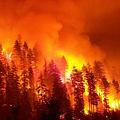 根據新研究報告的測定結果,森林大火會使臭氧層污染超越美國所規定危害公共健康與環境標準。
根據新研究報告的測定結果,森林大火會使臭氧層污染超越美國所規定危害公共健康與環境標準。
國家大氣研究中心(National Center for Atmospheric Research,NCAR)的科學家所進行的這項研究著重在2007年於加州所發生的大火災,發現火災不斷致使大範圍區域的地表臭氧層突破不安全值,包含加州以及鄰近內華達州大部分的鄉村地區。
火災會放出氮氧化合物以及碳氫化合物,而使臭氧值惡化,上述兩種化合物在陽光下進行化學反應,因而能在火源附近或下風處形成臭氧。
這項研究在10月9日的《地球物理研究通訊》(Geophysical Research Letters)刊出,由美國太空總署以及國家科學基金會出資進行,國家科學基金會同時也贊助國家大氣研究中心(NCAR)。
這項研究主筆人,也是國家大氣研究中心科學家的費斯特(Gabriele Pfister)表示:「了解森林火災人類健康的衝擊非常重要。臭氧甚至可能在人類看不到任何煙霧的地方達到不安全的標準。」雖然科學家早就了解森林火災排放空氣微粒和各式氣體對空氣品質的影響,卻鮮少針對這些影響進行量化研究。
這次研究的專家們利用電腦模型和地表偵測儀器相結合,測讀2007年9月和10月發生的加州大火災。他們發現比起沒有火焰出現的地區,在有火焰的地區臭氧達到不安全標準的可能性高達3倍之多。
大火災發生超過8小時內,臭氧濃度即已達到美國國家環境保護局訂定人體健康標準的0.08ppm。
自此美國環境保護局(EPA)將標準緊縮為0.075ppm。因為標準變得更為嚴格,因此達到不安全標準的次數增加將近兩倍之多。
臭氧在平流層能阻擋來自太陽的紫外線,對地球生物有保護作用,然而臭氧在較低的大氣層則會引起健康問題。
包括咳嗽、喉嚨不適到更嚴重的問題,像是氣喘惡化、支氣管炎和肺氣腫等。地表臭氧污染也會損害作物和其他植物。
費斯特表示:「我們預期大火災的狀況在未來會更嚴重,尤其是氣候不斷暖化的情形下。」「但是我們才剛開始了解大火災對人類和生態系統的潛在衝擊,不只是對發生大火災的鄰近之處,甚至是遠方的下風處的影響。」
研究者偵測到的不安全臭氧濃度值多數發生在鄉村地區。這樣子的結果可能是因為電腦模型缺乏詳盡的資料更貼近研究人口住宅相對較為緊密的都市地區。
不過這項報告的作者群也猜測野火氣體排放對鄉村地區的臭氧濃度衝擊大於都市地區。
他們認為城市通常氮氧化合物較多,這項污染物濃度一高,就會影響臭氧製造的效率,甚至破壞臭氧。
這份研究報告的共筆人之一,國家大氣研究中心科學家維汀麥爾表示:「森林火災對臭氧在市郊與鄉村地區的影響,和城市其他污染源不同,相當容易受到注意。」
這份報告也注意到如果不是十月的聖塔安那風將森林大火吹向太平洋,遠離污染區,臭氧的濃度可能還會高的多。
Wildfires can hike ozone pollution to levels that violate U.S. public health and environmental standards, new research has determined.
The study by scientists at the National Center for Atmospheric Research focused on California wildfires in 2007, finding that they repeatedly caused ground-level ozone to spike to unhealthy levels across a broad area, including much of rural California as well as neighboring Nevada.
Fires worsen ozone levels by releasing nitrogen oxides and hydrocarbons, which can form ozone near the fire or far downwind as a result of chemical reactions in sunlight.
The study was published today in "Geophysical Research Letters." It was funded by NASA and by the National Science Foundation, which sponsors NCAR.
"It's important to understand the health impacts of wildfires," says NCAR scientist Gabriele Pfister, the lead author. "Ozone can hit unhealthy levels even in places where people don't see smoke."
Although scientists have long known that wildfires can affect air quality by emitting particles and gases into the air, there has been little research to quantify the impacts.
The researchers, using a combination of computer models and ground-level measurements, studied intense California wildfires that broke out in September and October of 2007. They found that ozone was three times more likely to violate safe levels when fire plumes blew into a region than when no plumes were present.
At the time of the wildfires, the public health standard for ozone set by the U.S. Environmental Protection Agency was 0.08 parts per million over an eight-hour period.
The EPA has since tightened the standard to 0.075 parts per million. Under the stricter standard, the number of violations would have nearly doubled.
While ozone in the stratosphere benefits life on Earth by blocking ultraviolet radiation from the Sun, ozone in the lower atmosphere can trigger health problems.
These range from coughing and throat irritation to more serious problems, such as aggravation of asthma, bronchitis, and emphysema. Ground-level ozone pollution also damages crops and other plants.
"Wildfires are expected to worsen in the future, especially as our climate grows warmer," Pfister says. "But we are only now beginning to understand their potential impacts on people and ecosystems, not only nearby but also potentially far downwind."
The unhealthy levels of ozone the researchers detected occurred mostly in rural areas. This finding may be a result of the computer modeling, which lacked the fine detail to zoom in on relatively compact urban areas.
But the authors also speculate that wildfire emissions have a greater impact on ozone levels in the countryside than on cities.
They say cities tend to have more nitrogen dioxide, a pollutant that can, at high levels, reduce the efficiency with which ozone is produced or even destroy ozone.
"The impact of wildfires on ozone in suburban and rural areas, far from urban sources of pollution, was quite noticeable," says NCAR scientist Christine Wiedinmyer, a co-author of the paper.
The paper notes that ozone levels would likely have been even greater except that Santa Ana winds in October blew wildfire plumes over the Pacific Ocean, safely away from populated areas.
全文及圖片詳見:ENS





